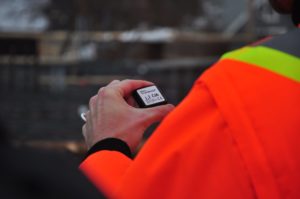Concrete is a permeable substance capable of absorbing and releasing moisture, which can continue to affect the RH of a slab long after it’s been placed.
Sources of Moisture in Concrete
There are many ways that moisture gets into a concrete slab. Ground moisture can enter either through capillary action or as water vapor. Groundwater might be present due to a high-water table or poor drainage. Other ways include high air humidity, high relative humidity in the environment or leaking plumbing that goes through the slab.
The high moisture in our story isn’t surprising given the age of the slab and the recent weather. Older slabs were often constructed without moisture barriers, or the moisture barrier has degraded over time. Or maybe a plumbing leak has developed.
High moisture levels in the concrete could also be hidden by the old flooring system. Older flooring adhesives and sealants were typically more moisture-resistant than today’s lower VOC products. You might remove an older floor that has performed perfectly well for years and find that the slab is too wet for today’s less moisture-resistant flooring systems.
Moisture Damage to Floors
Installing any type of floor over concrete that isn’t sufficiently dry can be disastrous. For wood floors, slabs with excessive moisture can cause adhesive failure, wood warping or cupping, gaps and creaking. Floor coatings can suffer from blistering and delamination. Sheet vinyl and vinyl tile floors can suffer adhesive failure and blistering. Mold and mildew are also common problems with excessive moisture.
Experienced flooring installers know that you can’t look at the surface of a concrete slab and know if it’s dry enough to install a floor. There may be large amounts of moisture hidden deep in the slab. After you install a floor, that hidden moisture can rise to the surface of the slab and cause the floor to fail. Over the years, various methods of moisture testing have been developed, but most of them are not scientifically based, accurate and reliable.
Learn more about relative humidity and sources of moisture in concrete Here
Probes and wired sensors are in-situ methods used to obtain accurate RH readings from fresh to hardened stages, according to ASTM F2170. However, these methods require you to drill holes into your slab, affecting the aesthetics and integrity of your flooring. In addition, drilling a hole in the concrete floor would change the flow of moisture, affecting the accuracy of RH measurements. That is why we have created BlueRock™, the most advanced wireless relative humidity and temperature sensor on the market.
Guarantee a level floor with continuous relative humidity monitoring

BlueRock™ is fully embedded in your concrete (secured on the rebar) to measure internal RH and temperature variations overtime. Unlike current time-consuming methods that measure only one data point at the time of testing, this wireless sensor continually collects data. This information can be used for quality control and quality assurance purposes, allowing you to optimize the time in which you place your floor covering material. It also helps monitor:
- Drying levels in concrete floors,
- Effectiveness of curing conditions,
- Optimization of flooring installation,
- Water penetration in concrete, and
- Relative humidity gradients.
What sets BlueRock™ apart from other RH and temperature sensors?

- Fast assessment and real-time results: BlueRock is equipped with wireless technology that sends RH and temperature data in real-time directly to your smartphone or tablet.
- Non-destructive testing capabilities: Unlike other concrete testing methods, this wireless sensor does not rely on destructive techniques to obtain accurate data, such as drilling a hole in concrete.
- Customizable measurement intervals: Decide how often you want RH measurements taken by setting your device to record sensor data anywhere from every few minutes to every couple of hours.
- Free BlueRock app: Available for both Android and iOS on any smart device.
- Shareable reports: BlueRock users can generate full reports in PDF and CSV formats and share with any team members.
- Easy installation: Installing the BlueRock device is as easy as tying the wires together around the rebar before pouring, fully embedding the sensor in concrete.
- Long battery life: BlueRock is equipped with a long-lasting battery that can measure up to two years of data.
Visit our BlueRock™ product page to learn more about how monitoring temperature and RH levels in your concrete can prevent flooring failures.




